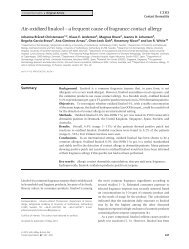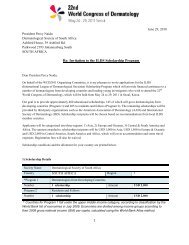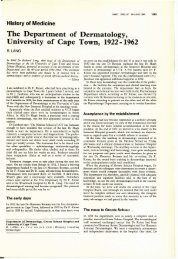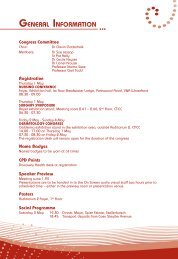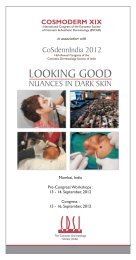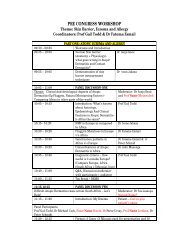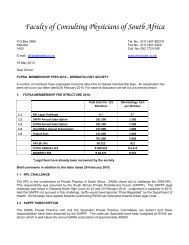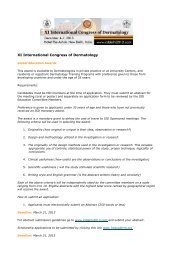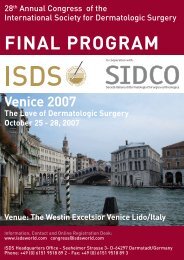Guidelines on the Management of Atopic Dermatitis ... - Dermatology
Guidelines on the Management of Atopic Dermatitis ... - Dermatology
Guidelines on the Management of Atopic Dermatitis ... - Dermatology
Create successful ePaper yourself
Turn your PDF publications into a flip-book with our unique Google optimized e-Paper software.
27. Kyll<strong>on</strong>en H , Remitz A, Mandelin JM, et al. Effects <strong>of</strong> 1 year intermittent treatment with topical<br />
tacrolimus m<strong>on</strong>o<strong>the</strong>rapy <strong>on</strong> skin collagen syn<strong>the</strong>sis in patients with atopic dermatitis. Br J<br />
Dermatol 2004;150:1174-81<br />
28. Luger TA, Lahfa R, Folster-Holst R, et al. L<strong>on</strong>g term safety and tolerability <strong>of</strong> pimecrolimus<br />
cream 1% and topical steroids in adults with moderate to severe atopic dermatitis. J<br />
Dermatological Treatm 2004;15:169-78<br />
29. Wahn U, Bos JD, Goodfield M, et al. Efficacy and safety <strong>of</strong> pimecrolimus cream in <strong>the</strong> l<strong>on</strong>g term<br />
management <strong>of</strong> atopic dermatitis in children. Pediatrics 2002;110:2<br />
30. US Food and Drug Administrati<strong>on</strong>. Safety: Elidel (pimecrolimus), Protopic (tacrolimus)<br />
[homepage <strong>on</strong> <strong>the</strong> Internet]. c2010. Available from:<br />
http://www.fda.gov/Safety/MedWatch/SafetyInformati<strong>on</strong>/SafetyAlertsforHumanMedicalProducts/<br />
ucm151161.htm<br />
31. Siegfried EC, Jaworski JC, Hebert EE. Topical Calcineurin Inhibitors and Lymphoma Risk:<br />
Evidence Update with Implicati<strong>on</strong>s for Daily Practice. Am J Clin Dermatol 2013;14:163–78<br />
32. Nati<strong>on</strong>al Institute for Clinical Excellence. Final appraisal determinati<strong>on</strong>: tacrolimus and<br />
pimecrolimus for atopic eczema http://www.nice.org.uk/nicemedia/live/11537/32895/32895.pdf<br />
FAD (PDF last accessed 21 June 2013)<br />
Use <strong>of</strong> photo<strong>the</strong>rapy in atopic dermatitis [1+; A]<br />
When topical modalities fail to c<strong>on</strong>trol atopic dermatitis, photo<strong>the</strong>rapy is <strong>the</strong> next opti<strong>on</strong>.<br />
Narrow band UVB (NB-UVB) is highly effective and has replaced broadband UVB for<br />
treating atopic dermatitis. Acutely inflamed atopic dermatitis patients do not tolerate UV well.<br />
Therefore <strong>the</strong> initial treatment will include immunomodulaters like ciclosporin or<br />
mycophenylate m<strong>of</strong>etil or immunosuppressives like azathioprine or methotrexate. Once <strong>the</strong><br />
acute inflammati<strong>on</strong> has settled, UVB can be instituted. 1,2,4,5,6,7<br />
If <strong>the</strong>re is significant erythroderma, UVL in very low doses has to be introduced to prevent<br />
n<strong>on</strong>specific irritancy and flaring <strong>of</strong> <strong>the</strong> atopic dermatitis. The dose escalati<strong>on</strong> is much slower<br />
than in patients with psoriasis. 1,2<br />
In patients with acute flares <strong>of</strong> atopic dermatitis, UVA-1 can be used. 1,2<br />
In patients in whom NB-UVB fails, photochemo<strong>the</strong>rapy (PUVA) can be effective. 2 This can<br />
be given topically (soak/bath PUVA) or systemically (oral PUVA). 1,2,6 Goeckerman <strong>the</strong>rapy<br />
with tar and UVB in a “day treatment” setting will improve more than 90% <strong>of</strong> patients with<br />
refractory atopic dermatitis, and prol<strong>on</strong>ged remissi<strong>on</strong> can be induced. 1,2,3,4,5<br />
References<br />
1. Friedmann PS, Arden-J<strong>on</strong>es MR, Holden CA. <strong>Atopic</strong> <strong>Dermatitis</strong>. In: Burns T, Breathnach S,<br />
Cox N, Griffiths C, editors. Rook‟s Textbook <strong>of</strong> <strong>Dermatology</strong>. 8th ed. West Sussex: Wiley<br />
Blackwell Publishers; 2010.P.24.27-24.28<br />
2. <strong>Atopic</strong> Eczema and n<strong>on</strong>-infectious Immunodeficiency Disorders. In: James WD, Berger TG and<br />
Elst<strong>on</strong> DM, editors. Andrew‟s Diseases <strong>of</strong> <strong>the</strong> Skin. Clinical <strong>Dermatology</strong> 11th ed. Elsevier<br />
Saunders: 2011.P.69.<br />
3. Krutmann J. Photo<strong>the</strong>rapy for atopic dermatitis. Clin Exp Dermatol 2000;25:552-8<br />
4. Reynolds NJ, Franklin V, Gray JC et al. Narrow-band ultraviolet B and broadband ultraviolet A<br />
photo<strong>the</strong>rapy in adult atopic eczema: A randomised c<strong>on</strong>trol trial. Lancet 2001;357:2012-6<br />
5. Tzaneva S, Seeber A, Schwaiger M et al. High-dose versus medium-dose UVA1 photo<strong>the</strong>rapy<br />
for patients with severe generalised atopic dermatitis. J Am Acad Dermatol 2001;45:503-7<br />
6. Der-Petrossian M, Seeber A, H<strong>on</strong>igsmann H, Tanow A. Half-side comparis<strong>on</strong> study <strong>on</strong> <strong>the</strong><br />
efficacy <strong>of</strong> 8-methoxypsoralen bath-PUVA versus narrow-band ultraviolet B photo<strong>the</strong>rapy in<br />
patients with severe chr<strong>on</strong>ic atopic dermatitis. Br J Dermatol 2000;142:39-43




